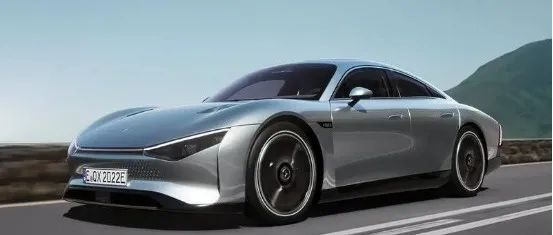The New Mercedes-Benz VISION EQXX Concept Car Targets the Tesla Model 3
What kind of situation could prompt a century-old European luxury brand to compete with the newcomer Tesla? The answer is a sense of fear of new challengers.
Mercedes-Benz, the leader in luxury cars, has been making big moves in the pure electric sector recently. Following the launch of the million-yuan pure electric flagship luxury sedan EQS in December, Mercedes announced another concept car, the VISION EQXX, on January 4th, which aims squarely at the Tesla Model 3 (or perhaps the next Tesla model).
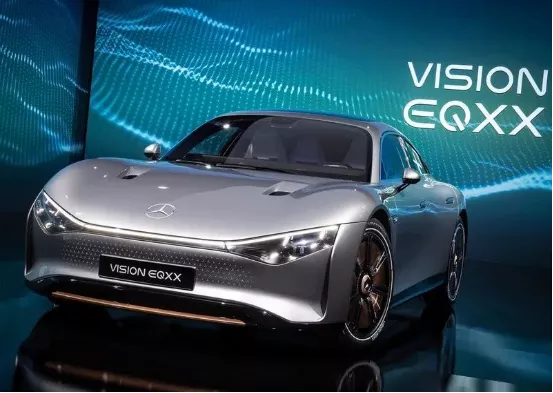
Why the Model 3? The VISION EQXX is based on the MMA platform, Mercedes’ compact and midsize electric platform. It has similar indicators in terms of length, wheelbase, and weight as the rear-wheel-drive version of the Tesla Model 3. The VISION EQXX is about 4630 mm long with a wheelbase of 2800 mm and weighs 1750 Kg, while the Model 3 is 4694 mm long with a wheelbase of 2875 mm and weighs 1761 Kg. The Model 3 is currently the best-selling electric car in 11 European countries; in 2021, 93,549 units were delivered.
What makes the VISION EQXX so powerful that Mercedes claims it could “beat the crap out” of everything, including the legendary “Eighteen Dragon Subduing Palms”?
Because according to Mercedes’ official introduction, the VISION EQXX is “the global pioneer and luxury leader in automotive technology.” For example, the concept car’s drag coefficient is as low as only 0.17 Cd, the energy consumption per 100 kilometers is less than 10 kWh, making it “the most efficient vehicle ever.” Hence, its range exceeds 1000 kilometers and can “drive all the way from Beijing to Nanjing” on one charge.
Moreover, the luxury that Mercedes has always taken pride in is particularly evident in this concept car. The EQS’s unique display screen, made up of three large screens, has made its rivals in awe. But in the VISION EQXX, Mercedes directly embedded a 47.5-inch curved screen with 8K resolution (7680×660 pixels) across the diagonal. Yes, it’s a single screen, a truly large screen, not just a triple or double screen. And it’s luxurious.
The VISION EQXX concept car is said to have extensively used digital tools such as virtual reality and augmented reality in its development process. It took only 18 months from conception to completion.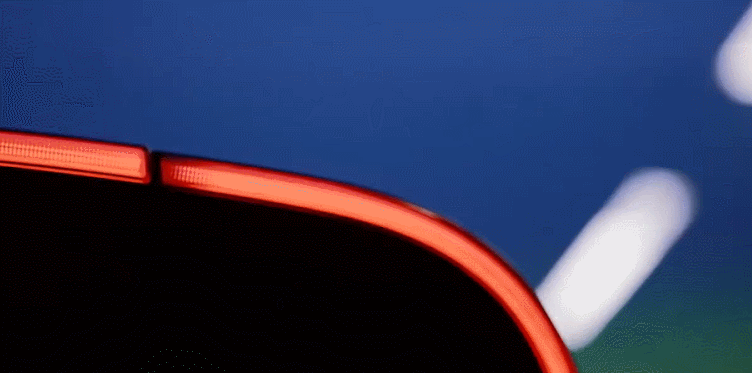
Mercedes-Benz, a century-old luxury car giant, has begun accelerating on pure electric circuits. The reason behind it is that the advantages of traditional automobile brands cannot be applied to the field of electric vehicles under the trend of electrification and intelligence. There are new rules and new standards in this new field, and the old brand name has little influence in the new field. Even as a luxury brand like Mercedes-Benz, it has to work harder in the new field and fight hard to avoid lagging behind.
What is this VISION EQXX concept car that showcases Mercedes-Benz’s technology and luxury in the field of electric vehicles? Let’s take a further look below.
Mercedes-Benz’s insistence on technology and luxury: Still working on the car body
As mentioned earlier, the drag coefficient of this VISION EQXX is only 0.17 Cd, and its power consumption is less than 10 kWh per hundred kilometers, making it “the most energy-efficient model in history.” How did Mercedes-Benz achieve this?
First, they started with the vehicle’s exterior. Students who love supercars know that whether it is Bugatti, McLaren, or other supercars, the body shape resembles a drop of water. This is because the object with the lowest drag coefficient in nature is a water droplet, with only 0.04 Cd. Therefore, supercars mimic the streamlined shape of water droplets to maximize the design of a streamlined body.
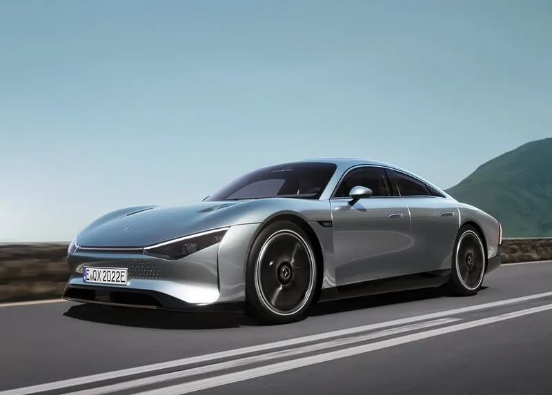
Mercedes-Benz VISION EQXX also used the drop shape to the extreme in pursuit of extremely low air resistance, with a small and flat front end paired with two exhaust vents for the cooling system on the hood. Personally, it doesn’t look like a catfish at all, but more like a devil fish. It can’t be described as beautiful, only special. The entire body of the car is very smooth, with almost no sharp edges, and the roof line slides towards the rear of the car like a water droplet. Paired with fully enclosed low-drag wheels, everything is to reduce air resistance.
Is reducing drag coefficient important for electric vehicles? Yes, it is quite important. Theoretically, for every 0.01 Cd reduction in drag coefficient, the range can be increased by 5-8 km. Therefore, the low air resistance pursued by Mercedes-Benz VISION EQXX is still to achieve its 1000 km range.
However, if the air resistance is too low, there are also disadvantages, such as insufficient downforce, which will weaken the stability of the vehicle during high-speed driving. How to solve it? Mercedes-Benz designers designed a unique and conspicuous tail for VISION EQXX. The upper part is an elongated and enlarged tail, and the lower part is a retractable diffuser. When the vehicle speed reaches above 60-70 km/h, the diffuser will automatically extend to help the vehicle maintain stability. Although the elongated and enlarged tail looks more like an old car’s long butt from the last century, when paired with the extended diffuser, it may attract more attention on the road.
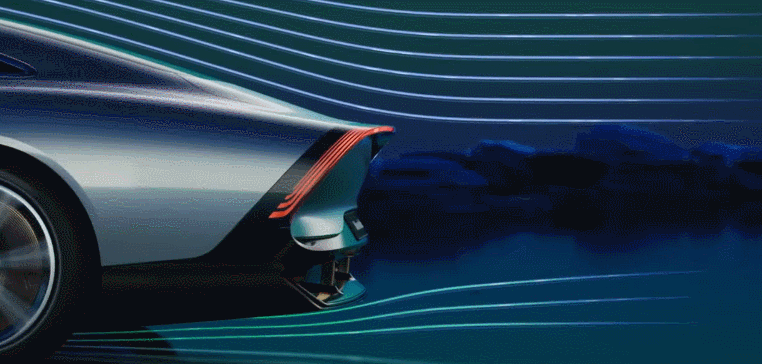
In order to achieve a range of 1000 km, Mercedes-Benz has tried to make this car as lightweight as possible. The VISION EQXX uses the “integral die-casting” technology, and the frame is formed by a single, independent casting without welding points. The rigidity of the rear part of the body is greatly improved and the material is saved because of the overall forming. The rear of the body also applies bionic engineering structural components, and the material is only used where it is needed according to the actual structural functional requirements, and unnecessary areas are hollowed out.
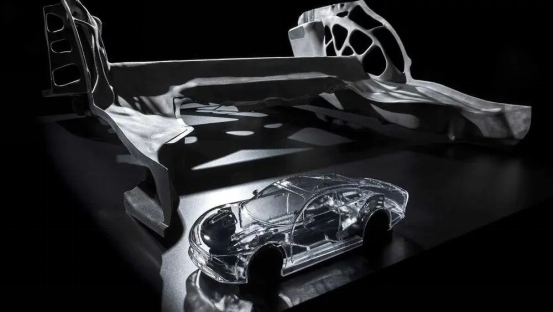
The battery pack of the VISION EQXX is also designed for weight reduction. The capacity of the concept car’s battery pack is 100 kWh, which is 50% smaller in size and 30% lighter than the new EQS battery pack. In order to minimize the number of modules, Mercedes-Benz directly “glued” the battery cells to the bottom shell of the VISION EQXX battery. This ultimately achieves an energy density of 400 Wh/L.
In order to achieve a range of 1000 km, Mercedes-Benz added 117 solar panels on the roof of the VISION EQXX concept car to supply power to low-voltage equipment such as air conditioning fans, lights, central control entertainment systems, and car-mounted 12V electronic devices. According to official Mercedes-Benz data, when there is sufficient sunlight, these solar panels can increase the range by 25 km. Of course, the price to pay for these solar panels on the roof is that you cannot have a sunroof or a panoramic sunroof anymore.
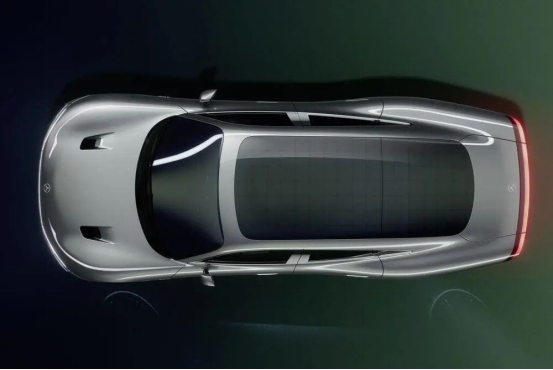
The luxury of the VISION EQXX concept car embodies the essence of the Mercedes-Benz brand. On the one hand, it is the unique and truly integrated large screen mentioned above. On the other hand, it is the “no luxury without environmental protection” and “no luxury without sustainability” advocated by luxury brands in recent years.
As for the large screen, the 47.5-inch ultra-thin seamless integrated display is unmatched by any other brand at present. In terms of material selection, environmentally friendly materials are extensively used in the interior decoration, which is the new luxury concept demonstrated by luxury brands.
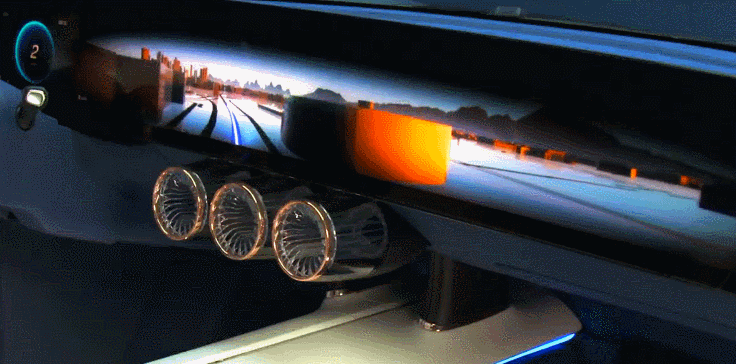 The door handle of VISION EQXX is made of biodegradable pure plant silk, which is truly innovative as it has been simplified to a small pull strap. The 3D dot-matrix decoration lining the car door is made of PET plastic bottles recycled by small color-changing flakes that can change color with different angles. The soft leather seats in the car are made of extract from cacti and mycelium, and the car carpet is woven from 100% bamboo fiber.
The door handle of VISION EQXX is made of biodegradable pure plant silk, which is truly innovative as it has been simplified to a small pull strap. The 3D dot-matrix decoration lining the car door is made of PET plastic bottles recycled by small color-changing flakes that can change color with different angles. The soft leather seats in the car are made of extract from cacti and mycelium, and the car carpet is woven from 100% bamboo fiber.
In any case, this eco-friendly luxury achieved with sustainable concepts and exquisite craftsmanship is worth giving Germans a thumbs up. However, whether it is technology or luxury, Mercedes-Benz still showcases its accumulated expertise and skill in the era of fuel-powered cars. To maintain its position in the fuel-powered car field, Mercedes-Benz still needs to do a lot of work to catch up in the electric car aspect.
Mercedes-Benz’s sales have shown a declining trend, and the electrification process needs to be accelerated.
Recently, Mercedes-Benz announced its quarterly and annual sales for 2021. The data shows that in the fourth quarter of 2021, Mercedes-Benz sold 464,130 vehicles worldwide, a year-on-year decrease of 24.6%. In 2021, Mercedes-Benz sold 2,093,476 passenger cars, a year-on-year decrease of 5.0%.
In terms of regions, Mercedes-Benz is still a popular luxury brand in the Chinese market, with S-Class, G-Class, AMG, and Maybach selling well nationwide. However, in 2021, Mercedes-Benz’s passenger car sales in China still fell slightly by 2.0% to 758,863 vehicles.
In comparison, the European market, where Mercedes-Benz originated, saw the largest decline in sales in 2021, down 11.2% to 696,136 vehicles. Mercedes-Benz’s sales in the North American market have increased slightly, with 318,456 vehicles sold in 2021, a year-on-year increase of 0.3%.
Mercedes-Benz attributes the main reason for its overall sales decline in 2021 to the “global semiconductor shortage,” which is one of the reasons it is willing to admit. Perhaps the other factor it is not willing to admit is the rapid electrification process in China and Europe in 2021, and the rapidly increasing penetration rate of new energy vehicles which is eating up the market share of traditional fuel-powered cars, including Mercedes-Benz.
According to the 2021 European electric car sales data released by eu-evs, a total of 853,075 electric cars were sold in 11 European countries, including Norway, Germany, the United Kingdom, France, Ireland, Spain, the Netherlands, Sweden, Switzerland, Denmark, and Finland, representing a year-on-year increase of 30.4%. Among them, Volkswagen sold 124,389 vehicles, Tesla sold 115,731 vehicles, and Renault sold 67,552 vehicles, ranking first, second, and third in sales, respectively.Mercedes-Benz ranked tenth with 28,220 vehicles sold, which is not impressive. Although Mercedes-Benz claims that its 2021 EQ series electric vehicle sales increased by 154.8% YoY to 48,936 units, there is still a significant gap compared to Volkswagen and Tesla.
In 2021, the Chinese market experienced a surge in sales of new energy vehicles. According to the China Association of Automobile Manufacturers, the wholesale volume of domestic new energy passenger cars reached 3.312 million units, an increase of 181.0% YoY, and the retail volume reached 2.989 million units, an increase of 169.1% YoY.
The wholesale penetration rate of new energy passenger vehicle manufacturers increased from 6.18% in 2020 to 15.7% in 2021, while the retail penetration rate increased from 5.8% in 2020 to 14.8% in 2021. Moreover, in November and December of 2021, the sales volume of domestic new energy passenger cars increased significantly, and the penetration rate had exceeded 20%, accelerating the grabbing of market share from traditional fuel vehicles.
These data reflect that the golden period of new energy vehicles, especially pure electric vehicles, has arrived in the Chinese market. The saying goes, “the early bird gets the worm, the later bird chews the bone, and the slowest only gets the soup.”
As such a large automobile consumer market, and with such an attractive electric vehicle bonus, does Mercedes-Benz not desire a share? Not only Mercedes-Benz but all traditional automakers were envious, and they all realized in 2021 that their electrification progress was too slow.
Therefore, Toyota turned around from hesitation and plans to launch 30 electric vehicle models in one go. General Motors pledged to raise its investment from US$200 billion to US$350 billion for electric vehicle research and development. Mercedes-Benz also announced that it will launch eight pure electric and plug-in hybrid models in the Chinese market in 2022, and invest over 40 billion Euros in the electric vehicle field to compete with Tesla by 2030.
Further detailed data shows that the penetration rate of new energy vehicles in the domestic luxury car market reached 32.7% in December 2021. This indicates that the continuously strengthening luxury car segment is no longer dominated by fuel vehicles, and new energy vehicles are becoming the new favorite of luxury car users.
If new energy vehicles are only occupying territories outside the luxury car market, it will not affect luxury brands like Mercedes-Benz significantly. Still, as new energy vehicles are rapidly spreading to the luxury car field, Mercedes-Benz cannot afford to remain complacent.
Therefore, it is understandable for Mercedes-Benz to be eager and vigorous in developing VISION EQXX, a concept car that was globally launched in January 2022 and may not be mass-produced until 2025. Perhaps Mercedes-Benz’s attitude towards electrification progress should be more sincere, and their thinking should be more open-minded.
This article is a translation by ChatGPT of a Chinese report from 42HOW. If you have any questions about it, please email bd@42how.com.
